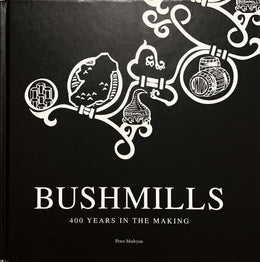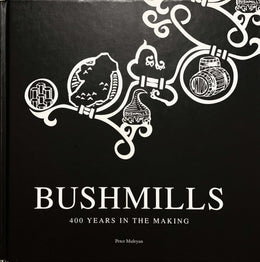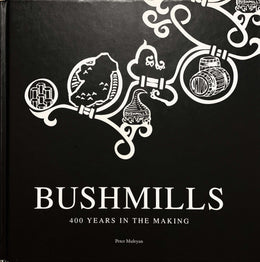
Illustration of Coleraine during the 19th century
Coleraine is one of the most fondly remembered of Ireland's numerous silent distilleries. The reasons are many: it made good whiskey; it closed relatively recently; and the odd bottle of single malt from 1959 can still be bought, if you have enough money. The 'Coleraine' label has also lived on as a blend; it has a small but loyal following and is sold almost exclusively in Northern Ireland.
Coleraine started life in the mid-1820s and by 1837 its owner, Thomas Black, was advertising "a large supply on sale at his stores, which will be sold cheap for Cash or good Bills". After that nifty line in sales and marketing, it is not surprising that the following year Black sold out to Michael Ferrar.
Ferrar built the company's reputation and by 1845 he was supplying Coleraine Whiskey to the House of Commons in London. There after the initials 'HC' appeared on each and every bottle of Coleraine, as did the crest of the City of London.
Robert Taylor took over the distillery in 1869, and his name hung over the door until the very end. His attention to detail meant this tiny distillery, which never produced more than 100,000 gallons a year, had a fine reputation. In fact after visiting each and every distillery in the then-United Kingdom of Great Britain and Ireland, Alfred Barnard was forced to concede: "In all our wanderings through Erin's Green Isle, for cleanliness, order and regularity, we have seen no distillery to beat this."
Coleraine started life in the mid-1820s and by 1837 its owner, Thomas Black, was advertising "a large supply on sale at his stores, which will be sold cheap for Cash or good Bills". After that nifty line in sales and marketing, it is not surprising that the following year Black sold out to Michael Ferrar.

Taylor was a clever businessman and a whiskey innovator; this meant that Coleraine was always leading change. When everyone was selling casks to the bonded trade, Taylor installed a bottling plant in the distillery, and while cheap patent blends were flooding the market, Taylor was moving up market, producing a ten-year-old bottling of his own malt whiskey.
After Robert Taylor's death, quality slipped and like every other Irish distillery, Coleraine suffered from the combined troubles of the Great War, American Prohibition and political unrest in Ireland. Like so many others concerns, the distillery was mothballed in the early 1920s. Although purchased by William Boyd in 1933 for its stocks of highly regarded whiskey, the plant didn't start back into production until 1938.

If James Watt Morrison was underwhelmed by what he saw when he started work at Old Bushmills, it will come as no surprise to hear he was even less happy with what he found at Coleraine. The boiler had been condemned, the heating tanks in the mash house were rotten through, but more interesting still was the stillroom. It contained four stills and two of them were not even designed to make whiskey. They were brandy stills.
"I had seen photographs of them," recalled Morrison. "They were spheres or balls with the bottom half set in a cast iron casing. They were small with a working content of 150. gallons and an exceedingly long or high head."
Today one of these stills can be seen in the visitors area at the Old Bushmills distillery, but at the time there was no money to change them. The stills had been making good whiskey, so they were pressed into service. Being so small in comparison with the wash stills, they had to be constantly filled and emptied.
A 1938 information sheet gave details of the revived distillery:
"Six months' intensive reconstruction work at the (Coleraine) Distillery culminate at the beginning of this week in the recommencement of the process of distillation. At the present moment whiskey is running from the stills which have been unemployed for a decade and a half, and is well up to the standard of former years."
But Coleraine wasn't long back in business before the Second World War took its toll. Barley was rationed, so the plant was once again mothballed. After the war, when small amounts of barley were released for distilling, Coleraine's quota was used at Old Bushmills. Coleraine hobbled along, but it produced malt whiskey very infrequently. It began to be used more and more as a support facility for Bushmills. The bottling line was moved there, then in 1954 a continuous still was installed in Coleraine; this was the beginning of what would one day become Black Bush whiskey.
Malt whiskey was only distilled periodically here until it ceased altogether in 1964. The bottling hall in Coleraine closed in 1968, and the facility finally fell silent in 1978 when Irish Distillers were in charge. They shifted all the production of grain whiskey to Cork.
During the 1930s right across the island of Ireland the whiskey business was in freefall, so when the tiny Killowen distillery, also in Coleraine, was put up for sale, it was an obvious purchase for Boyd. Killowen never had the kind of reputation that Coleraine enjoyed, but Boyd needed extra warehousing. Killowen was drafted into service to store the output of Bushmills and Coleraine.
Written by Peter Mulryan
The text is an excerpt from "Bushmills: 400 Years in the Making" (pp. 92 - 95), written by Peter Mulryan, published 2008 by Appletree Press Ltd.







